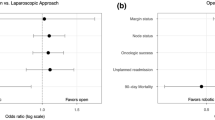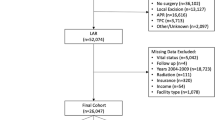Abstract
Background
There is ongoing debate regarding the benefits of minimally invasive techniques for rectal cancer surgery. The aim of this study was to compare pathologic outcomes of patients who underwent rectal cancer resection by open surgery, laparoscopy, and robotic surgery using the American College of Surgeons National Surgical Quality Improvement Program (ACS-NSQIP) proctectomy-targeted database.
Methods
All patients from the 2016 ACS-NSQIP proctectomy-targeted database who underwent elective proctectomy for rectal cancer were identified. Patients were divided into three groups based on initial operative approach: open surgery, laparoscopy, and robotic surgery. Pathologic and 30-day clinical outcomes were then compared between the groups. A propensity score analysis was performed to control for confounders, and adjusted odds ratios for pathologic outcomes were reported.
Results
A total of 578 patients were included—211 (36.5%) in the open group, 213 (36.9%) in the laparoscopic group, and 154 (26.6%) in the robotic group. Conversion to open surgery was more common among laparoscopic cases compared to robotic cases (15.0% vs. 6.5%, respectively; p = 0.011). Positive circumferential resection margin (CRM) was observed in 4.7%, 3.8%, and 5.2% (p = 0.79) of open, laparoscopic, and robotic resections, respectively. Propensity score adjusted odds ratios for positive CRM (open surgery as a reference group) were 0.70 (0.26–1.85, p = 0.47) for laparoscopy and 1.03 (0.39–2.70, p = 0.96) for robotic surgery.
Conclusions
The use of minimally invasive surgical techniques for rectal cancer surgery does not appear to confer worse pathologic outcomes.
Similar content being viewed by others
References
Heald RJ (1988). The holy plane of rectal surgery. J R Soc Med 81:503.
Kusters M, Marijnen CA, van de Velde CJ, et al (2010). Patterns of local recurrence in rectal cancer; a study of the Dutch TME trial. Eur J Surg Oncol 36:470–476.
Parfitt JR, Driman DK (2007). The total mesorectal excision specimen for rectal cancer: a review of its pathological assessment. J Clin Pathol 60:849–855.
Nagtegaal ID, Quirke P (2008). What is the role for the circumferential margin in the modern treatment of rectal cancer?. J Clin Oncol 26:303–312.
Simunovic M, Baxter NN, Sutradhar R, et al (2013). Uptake and patient outcomes of laparoscopic colon and rectal cancer surgery in a publicly funded system and following financial incentives. Ann Surg Oncol 20:3740–3746.
Schootman M, Hendren S, Ratnapradipa K, et al (2016). Adoption of robotic technology for treating colorectal cancer. Dis Colon rectum 59:1011–1018.
Carmichael JC, Masoomi H, Mills S, et al (2011). Utilization of laparoscopy in colorectal surgery for cancer at academic medical centers: does site of surgery affect rate of laparoscopy?. Am Surg 77:1300–1304.
van der Pas MH, Haglind E, Cuesta MA, et al (2013). COLOR II Study Group. Laparoscopic versus open surgery for rectal cancer (COLOR II): short-term outcomes of a randomised, phase 3 trial. Lancet Oncol 14:210–218.
Kang SB, Park JW, Jeong SY, et al (2010). Open versus laparoscopic surgery for mid or low rectal cancer after neoadjuvant chemoradiotherapy (COREAN trial): short-term outcomes of an open-label randomised controlled trial. Lancet Oncol 11:637–645.
Stevenson AR, Solomon MJ, Lumley JW, et al (2015). ALaCaRT Investigators. Effect of laparoscopic-assisted resection vs open resection on pathological outcomes in rectal cancer: the ALaCaRT randomized clinical trial. JAMA 314:1356–1363.
Fleshman J, Branda M, Sargent DJ, et al (2015). Effect of laparoscopic-assisted resection vs open resection in stage II or III rectal cancer on pathologic outcomes: the ACOSOG Z6051 randomized clinical trial. JAMA 314:1346–1355.
Spinelli A, D’Hoore A, Panis Y, et al (2017). Critical appraisal of two randomized clinical trials on pathologic outcomes: laparoscopic vs. open resection for rectal cancer. Coloproctol 39:277.
Hellan M, Ouellette J, Lagares-Garcia JA, et al (2015). Robotic rectal cancer resection: a retrospective multicenter analysis. Ann Surg Oncol 22:2151–2158.
Sammour T, Malakorn S, Bednarski BK, et al (2016). Oncologic outcomes after robotic proctectomy for rectal cancer: analysis of a prospective database. Ann Surg Dec16; [Epub ahead of print]. Accessed on Nov 27, 2017.
Jayne D, Pigazzi A, Marshall H, et al (2017). Effect of robotic-assisted vs. conventional laparoscopic surgery on risk of conversion to open laparotomy among patients undergoing resection for rectal cancer: the ROLARR randomized clinical trial. JAMA 318:1569–1580.
SilvaVelazco J, Dietz DW, Stocchi L, et al (2017). Considering value in rectal cancer surgery: an analysis of costs and outcomes based on the open, laparoscopic, and robotic approach for proctectomy. Ann Surg 265:960–968.
Baek SJ, Kim SH, Cho JS, et al (2012). Robotic versus conventional laparoscopic surgery for rectal cancer: a cost analysis from a single institute in Korea. World J Surg 36:2722–2729.
Hottenrott C (2011). Robotic versus laparoscopic surgery for rectal cancer and cost-effectiveness analysis. Surg Endosc 25:3954–3956.
Al-Khamis A, Abou Khalil J, Demian M, et al (2016). Sigmoid colectomy for acute diverticulitis in immunosuppressed vs. immunocompetent patients: outcomes from the ACS-NSQIP database. Dis Colon rectum 59:101–109.
Cepeda MS, Boston R, Farrar JT, et al (2003). Comparison of logistic regression versus propensity score when the number of events is low and there are multiple confounders. Am J Epidemiol 158:280–287.
Ridgeway G, McCaffrey DF, Morral A, et al (2017). Twang: toolkit for weighting and analysis of nonequivalent groups. Available at: https://CRAN.R-project/org/package=twang.
McCaffrey DF, Griffin BA, Almirali D, et al (2013). A tutorial on propensity score estimation for multiple treatments using generalized boosted models. Stat Med 32:3388–3414.
Meyerhardt JA, Tepper JE, Niedzwiecki D, et al (2004). Impact of body mass index on outcomes and treatment-related toxicity in patients with stage II and III rectal cancer: findings from Intergroup Trial 0114. J Clin Oncol 22:648–657.
You JF, Tang R, Changchien CR, et al (2009). Effect of body mass index on the outcome of patients with rectal cancer receiving curative anterior resection: disparity between the upper and lower rectum. Ann Surg 249:783–787.
Chern H, Chou J, Donkor C, et al (2010). Effects of obesity in rectal cancer surgery. J Am Coll Surg 211:55–60.
Thorpe H, Jayne DG, Guillou PJ, et al (2008). MRC-CLASICC Trial Group. Patient factors influencing conversion from laparoscopically assisted to open surgery for colorectal cancer. Br J Surg 95:199–205.
Qiu Y, Liu Q, Chen G, et al (2016). Outcome of rectal cancer surgery in obese and nonobese patients: a meta-analysis. World J Surg Oncol 14:23.
Allaix ME, Furnee EJB, Mistrangelo M, et al (2016). Conversion of laparoscopic colorectal resection for cancer: what is the impact on short-term outcomes and survival?. World J Gastroenterol 22:8304:8313.
Freemantle N, Calvert M, Wood J, et al (2003). Composite outcomes in randomized trials: greater precision but with greater uncertainty?. JAMA 289:2554–2559.
Taylor FG, Quirke P, Heald RJ, et al (2011); MERCURY Study Group. Preoperative high-resolution magnetic resonance imaging can identify good prognosis stage I, II, and III rectal cancer best managed by surgery alone: a prospective, multicenter, European study. Ann Surg 253:711–719.
Mak TW, Lee JF, Futaba K, et al (2014). Robotic surgery for rectal cancer: a systematic review of current practice. World J Gastroenterol Oncol 6:184–193.
Sujatha-Bhaskar S, Jafari MD, Gahagan JV, et al (2017). Defining the role of minimally invasive proctectomy for locally advanced rectal adenocarcinoma. Ann Surg 266:574–581.
Prete FP, Pezzolla A, Prete F, et al (2017). Robotic versus laparoscopic minimally invasive surgery for rectal cancer: a systematic review and meta-analysis of randomized controlled trials. Ann Surg Oct 3; [Epub ahead of print]. Accessed on Nov 27, 2017.
Moghadamyeghaneh Z, Phelan M, Smith BR, et al (2015). Outcomes of open, laparoscopic, and robotic abdominoperineal resections in patients with rectal cancer. Dis Colon rectum 58:1123–1129.
Sun Z, Kim J, Adam MA, et al (2016). Minimally invasive versus open low anterior resection: equivalent survival in a national analysis of 14,033 patients with rectal cancer. Ann Surg 263:1152–1158.
Khreiss W, Huebner M, Cima RR, et al (2014). Improving conventional recovery with enhanced recovery in minimally invasive surgery for rectal cancer. Dis Colon rectum 57:557–563.
Vignali A, Elmore U, Cossu A, et al (2016). Enhanced recovery after surgery (ERAS) pathway vs. traditional care in laparoscopic recta resection: a single-center experience. Tech Coloproctol 20:559–566.
Huo YR, Phan K, Morris DL, et al (2017). Systematic review and meta-analysis of hospital and surgeon volume/outcome relationships in colorectal cancer surgery. J Gastrointest Oncol 8:534–546.
Leonard D, Penninckx F, Kartheuser A, et al (2014). PROCARE. Effect of hospital volume on quality of care and outcome after rectal cancer surgery. Br J Surg 101:1475–1482.
Richardson DP, Porter GA, Johnson PM (2013). Surgeon knowledge contributes to the relationship between surgeon volume and patient outcomes in rectal cancer. Ann Surg 257:295–301.
Acknowledgments
Laurent Azoulay is the recipient of a Chercheur-Boursier award from the Fonds de Recherche du Quebec–Santé and a William Dawson Scholar award from McGill University.
Author information
Authors and Affiliations
Contributions
RG, MAK, SB, NWC, LA, NM, CAV and MB have all met the following criteria for authorship:
-Substantial contributions to the conception or design of the work; or the acquisition, analysis or interpretation of data for the work, and
-Drafting the work or revising it critically for important intellectual content; and
-Final approval of the version to be published, and
-Agreement to be accountable for all aspects of the work in ensuring that questions related to the accuracy or integrity of any part of the work are appropriately investigated and resolved.
Corresponding author
Ethics declarations
Conflict of Interest
The authors declare that they have no conflict of interest.
Additional information
The American College of Surgeons National Surgical Quality Improvement Program and the hospitals participating in the ACS NSQIP are the source of the data used herein; they have not verified and are not responsible for the statistical validity of the data analysis or the conclusions derived by the authors.
Rights and permissions
About this article
Cite this article
Garfinkle, R., Abou-Khalil, M., Bhatnagar, S. et al. A Comparison of Pathologic Outcomes of Open, Laparoscopic, and Robotic Resections for Rectal Cancer Using the ACS-NSQIP Proctectomy-Targeted Database: a Propensity Score Analysis. J Gastrointest Surg 23, 348–356 (2019). https://doi.org/10.1007/s11605-018-3974-8
Received:
Accepted:
Published:
Issue Date:
DOI: https://doi.org/10.1007/s11605-018-3974-8




